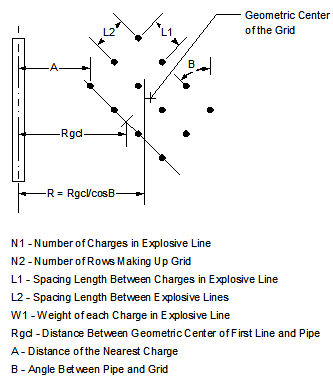Many oil, and gas pipeline companies have minimum requirements regarding blasting around their pipeline facilities. A common blasting requirement is blasting within 200 feet or using vibratory equipment within 25 feet of a pipeline. Unfortunately, blasting take places at very close proximities due to construction and other real activities such sewer, water, cable, etc. that cause stresses to these pipelines.
Many studies have been conducted Pipeline Research Committee with the objective to record and analyze the stresses on steel pipelines due to construction blasting in homogenous soils. Technical reports are in Volumes I and II of the final engineering report which describes an extensive research program conducted developed equations and methods for predicting the stresses in buried steel pipelines caused by nearby buried detonations. This research program was performed during the period 1975 through 1980 by Southwest Research Institute (SwRI) for the Pipeline Research Committee (PRCI) of the American Gas Association (A.G.A.).
In addition, a 1991 a report was produced by PRCI and Southwest Research Institute to study pipeline response to blasting in rock. The maximum pipe stresses induced by blast were assessed from the measured strains in both circumferential and longitudinal directions. Analysis of these stresses and comparison with previous blasting equations revealed that the single point source equation provides a realistic upper bound estimate of the stresses to be expected. All these studies were centered around steel pipelines.
Below is an example of an Angled Grid Charge Layout:

Work Plans and Safety should be part of a pipeline operator’s operation and maintenance (O&M) plan. Example, a plan of the project drawings must be to scale, showing the location of the project and indicating where changes in grade are proposed to the surface of rights-of-way. Existing and proposed elevations must be shown and verified by all parties. Because there are many unknowns, the calculations give an estimate of the stresses to the pipeline. Several requests have been made to include the 34% safety factor by Southwest Research in the equations that Technical Toolboxes provides.
Technical Toolboxes will provide the option in our next release. In addition, Technical Toolboxes provides a training course “Damage by Outside Forces” as well as having a SME consulting partner to assist in this area.
